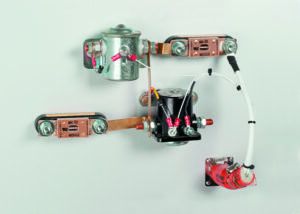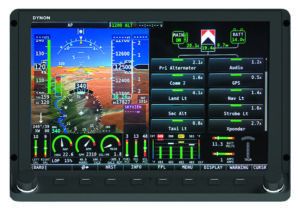If you’re building an aircraft from a kit, you probably agonize over which avionics to go with. But almost as important as the avionics suite is the electrical distribution bus that powers them—and the other electrical systems on the aircraft.
If you come from the certified aircraft world, you’re used to the old-school mechanical circuit breakers and single-point-failure bus configuration. Washington-based Vertical Power has a worthy solution with the PPS and VP-X power distribution systems. They can simplify the electrical wiring as a whole, while offering serious failsafe capabilities. Here’s a summary.
PRIMARY POWER SYSTEM
First, the Vertical Power PPS or Primary Power System. Think of the $1695 PPS as the main link between the aircraft battery and the rest of the electrical components on the aircraft.
The PPS module measures 4.7 by 8.6 inches, weighs 1.6 pounds and generally mounts to the aircraft firewall. The PPS works in 14- and 28-volt systems, has solid-state circuitry and controls power from the battery to the starter and the main bus. It also ties into the alternator B-lead(s) so that alternator power can both charge the battery and provide power to the main bus.
The PPS functions as a single-bus architecture and supports a single battery and one or two alternators. You can also tie in small backup batteries (and electronic bus circuits) directly into the PPS via the battery terminal. It’s important to mention that a single PPS isn’t a true dual-bus system, although you can use dual PPS modules to create one. Perhaps what we like best is that the PPS has digital fault outputs to warn of an alternator failure.
The PPS comes with everything you need to install it, including a hardware kit for mounting the module and a wiring harness kit with the accessories needed to wire the J1 circular connector. The wiring includes terminals that are already crimped on one end.
The PPS uses a dedicated external master switch (or switches if you want more redundancy), which makes connection to ground and bus voltage. The installation manual has good diagrams, and offers two ways to wire the PPS with the company’s VP-X and with traditional electrical buses.
The PPS has an 80-amp continuous main bus output, 80-amp continuous alternator input and a 300-amp max continuous starter output, and you can use it with dual alternators connected in parallel. But the PPS only scratches the surface of electronic power distribution. The interface is really expanded with the company’s VP-X Electronic Circuit Breaker System.
NO MORE BREAKERS

At least no more mechanical circuit breakers or fuses, because the Vertical Power VP-X Pro and VP-X Sport make them electronic for onscreen interface. This has long been the standard in high-end avionics systems for jets and it’s becoming the new standard for experimentals and LSAs.
There are two models, to include the $1695 VP-X Sport and $2395 VP-X Pro, which differ by electrical system compatibility (the VP-X Sport is for 14-volt systems only and the Pro works in 14- or 28-volt systems) and the number of available circuits, processors and power supplies (the Pro has dual processors and dual power supplies for redundancy). The physical installation for both products is identical, as is the setup. Both the Pro and Sport compact modules have dual D-sub 25-pin connectors and can be mounted behind the instrument panel or anyplace suitable for remote avionics and accessories. There are six connectors on the VP-X Pro and five on the VP-X Sport. Three of these connectors carry high-current loads and two D-subs are used for low-current systems, including a trim motor, as an example. An Ethernet connector is for Windows-based configuration and software updates.

The VP-X Pro has 32 switched power inputs (24 circuits on the Sport model) and what Vertical Power calls Dual Bank technology, or two independent power banks in a single system for redundancy. This means you can divide avionics and other electrical loads between two power banks, and in case one bank controller fails the other bank will continue to operate independently and provide power to the starter contactor.
Each bank of circuits is powered by an independent power supply and microprocessor. Moreover, the two banks (A and B) do not share common components on the circuit board—each bank is isolated from the other outside of the main power bus input and ground. We like that either bank can power the aircraft’s starter circuit, so you should always be able to get an engine started if one channel fails. Of course, you could still have a failure of the master switch or battery contactor, but these are relatively rare.

For controlling specific systems, there’s plenty of failsafe. For instance, radios, lights or displays can be divided up between power bank A and B so that each bank has one of each type of device. That way if a bank fails, the redundant device on the other bank still has power. You can do plenty of custom configuring.
For example, if you have two comm radios or dual navigators, put one on each bank. If you have a separate taxi light and a landing light, put one on each bank. But use caution—some systems have dual power inputs (including some Garmin navigators)—and both power inputs need to be on the same bank.
Avionics aren’t the only systems the VP-X can control. There’s a landing and taxi light interface with built-in wig-wag feature. That’s where the landing light shines steady when the aircraft is on the ground and pulses when the aircraft is airborne.
EFIS COMPATIBLE
The Vertical Power systems have a healthy interface potential with popular EFIS models. This includes the Garmin G3X Touch, Dynon SkyView series, Advanced Flight Systems, MGL Avionics, Grand Rapids Technologies and Levil Aviation, to name a few.
The Advanced Flight Systems ACM (Advanced Control Module) also has electronic circuit breakers and takes the interface to another level, functioning as an avionics wiring hub with prefab harnesses.
We’ll look at it in an avionics hub roundup article in an upcoming issue of Aviation Consumer.
Visit www.verticalpower.com.


